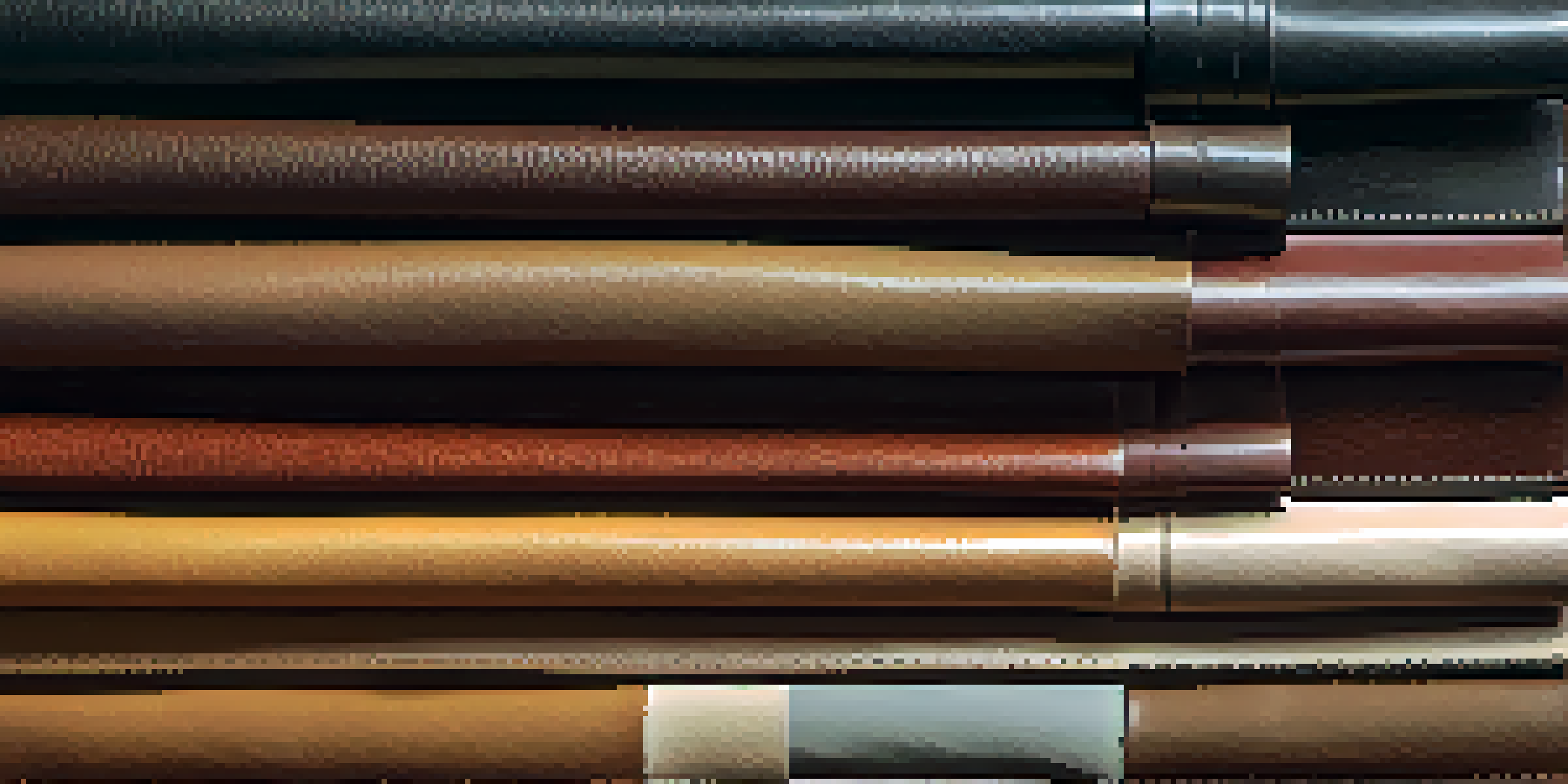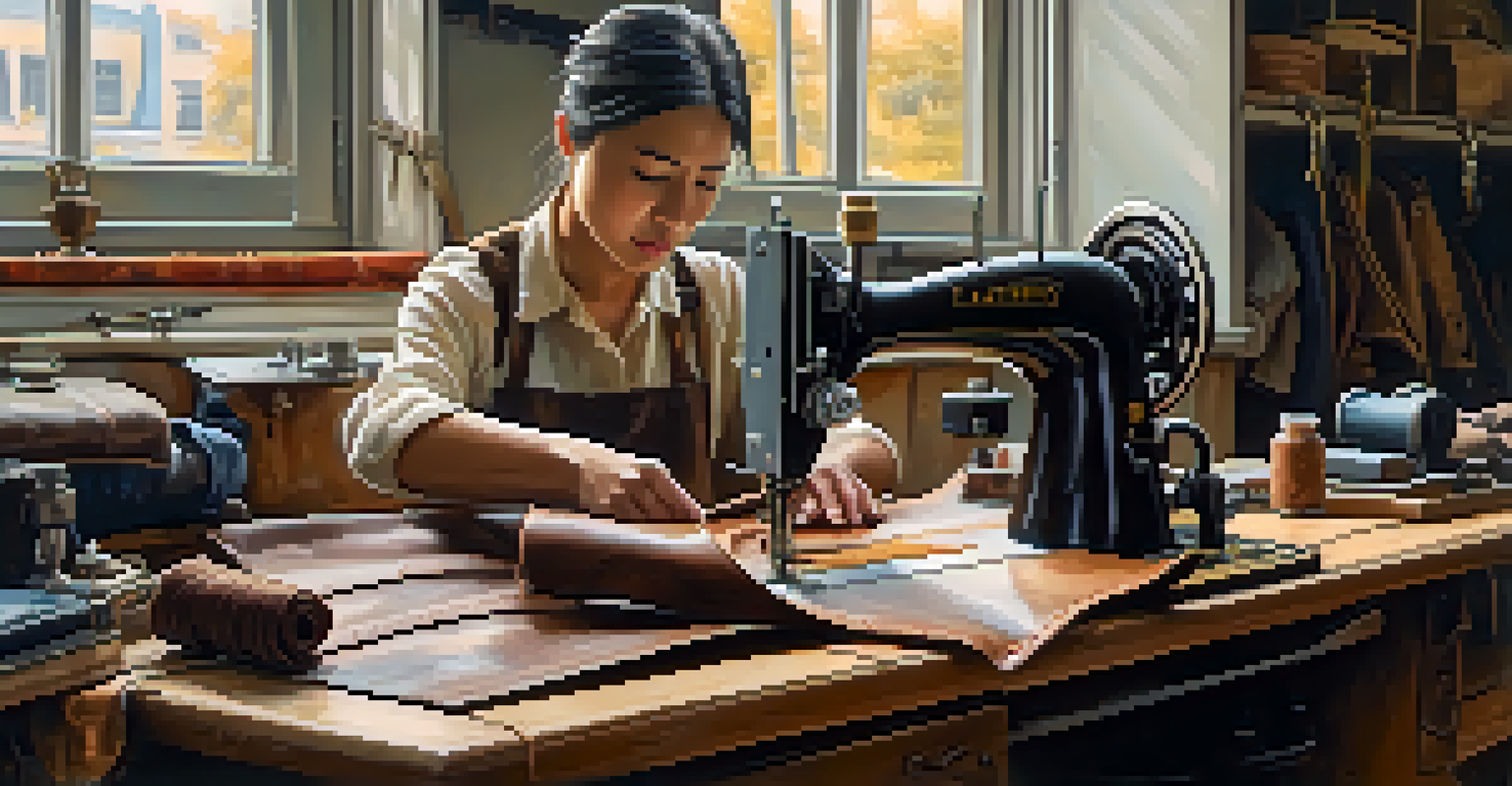Choosing the Right Thread and Needle for Leather Projects

Understanding Leather Types for Your Projects
Before diving into the specifics of thread and needle selection, it's crucial to understand the type of leather you're working with. Leather comes in various types, including top-grain, suede, and full-grain, each with unique characteristics. Knowing your leather type will influence the thickness and strength of the thread and needle you'll need.
The difference between a good and a great leather project is often in the details.
For example, full-grain leather, known for its durability and natural finish, often requires a heavier thread to withstand tension. On the other hand, suede, which has a softer texture, may benefit from a lighter thread that won’t overwhelm its delicate fibers. Tailoring your choices based on leather type sets the foundation for a successful project.
Ultimately, recognizing the nuances of different leather types not only enhances the aesthetic of your work but also ensures long-lasting results. So, take a moment to familiarize yourself with the leather at hand before moving on to the next steps in your crafting journey.
Selecting the Right Thread Material for Leather
When it comes to thread, material selection is key. Common options for leather projects include polyester, nylon, and cotton threads, each offering distinct advantages. For instance, polyester thread is strong and resistant to UV rays, making it ideal for outdoor leather goods.

Nylon thread, known for its elasticity, is another excellent choice, particularly for items that will experience a lot of movement, like bags or belts. Cotton thread, while aesthetically pleasing, may not have the same durability as synthetic options, so it's often best reserved for decorative stitching or lighter leather projects.
Know Your Leather Type
Understanding different leather types is essential as it impacts the choice of thread and needle for your projects.
Ultimately, the right thread material not only affects the durability of your project but also its overall appearance. Choosing wisely will ensure that your leather creations stand the test of time while looking great in the process.
Determining the Appropriate Thread Thickness
Thread thickness, often measured by weight, plays a significant role in the success of your leather projects. A general rule of thumb is to choose thicker threads for heavier leather and thinner threads for lighter materials. This balance ensures that the stitching is both functional and visually appealing.
Quality is not an act, it is a habit.
For instance, if you're working with thick saddle leather, opting for a thread weight of 138 or higher can provide the necessary strength. Conversely, lightweight leathers may only require a thread weight of 69 to maintain a sleek look without compromising integrity.
Finding the right thread thickness can greatly enhance the quality of your finished product. Experimenting with different weights on scrap pieces can help you visualize how they'll look on your final project.
Choosing the Right Needle Size for Leather
Selecting the appropriate needle size is just as crucial as choosing the right thread. Needles come in various sizes, typically ranging from 60/8 to 120/19, and the right size largely depends on both the thread thickness and the leather type. A larger needle is necessary for thicker threads to create a proper hole without tearing the leather.
For example, if you're using heavy-duty thread (like a weight of 138), a needle size of 110/18 or larger is recommended. On the other hand, if you're working with a lighter thread and softer leather, a smaller needle (like 80/12) will suffice, making sure to avoid unnecessary damage.
Choose the Right Thread Material
Selecting the appropriate thread material enhances durability and appearance, ensuring your leather creations last.
In essence, understanding the relationship between thread size and needle size helps ensure that your stitches are uniform and your leather remains intact. Pairing the right needle with your selected thread can elevate the entire project.
Exploring Needle Types for Leather Projects
Needles are not one-size-fits-all, especially when it comes to leather. There are specialized needles designed specifically for leather work, such as leather or wedge needles, which feature a sharp point to pierce through tough materials. These needles help prevent the leather from fraying and ensure clean, precise stitches.
In contrast, universal needles may be suitable for lighter leather but can struggle with heavier materials. It's essential to choose a needle that matches your project requirements to avoid frustration later on. The right needle can make the stitching process smoother and more enjoyable.
Ultimately, taking the time to research and select the appropriate needle type will pay off in your leather crafting endeavors. A little investment in the right tools can lead to more professional-looking results.
Testing Thread and Needle Combinations
Before committing to your chosen thread and needle combination for your main project, it's wise to conduct a test run. Using scraps of the same leather allows you to see how the thread and needle work together, ensuring that your final product meets your expectations. It also gives you a chance to adjust tension and stitching techniques to find what works best.
During this testing phase, pay close attention to how the needle penetrates the leather and how the thread lays within the stitch. If you notice any issues, like skipped stitches or excessive fraying, it may be time to reconsider your choices. This step can save you time and materials in the long run.
Test Before You Commit
Conducting test runs with thread and needle combinations on scrap leather helps avoid issues in your final project.
In short, testing different combinations before you start on your final piece can help you avoid potential pitfalls. It’s a small step that can make a significant difference in the quality of your finished leather project.
Final Tips for Successful Leather Crafting
As you embark on your leather crafting journey, keeping a few final tips in mind can enhance your experience. First, always ensure your needle is sharp and in good condition, as a dull needle can cause damage to your leather and lead to frustration. Regularly replacing worn-out needles is a good practice.
Additionally, don't hesitate to experiment! Leather crafting is as much about creativity as it is about technique. Trying out different thread colors and stitching patterns can add a personal touch to your projects, making them truly unique.

Lastly, be patient with yourself. Crafting with leather can sometimes be challenging, but every project is an opportunity to learn and improve. With the right tools and a little practice, you'll be well on your way to creating beautiful leather pieces.